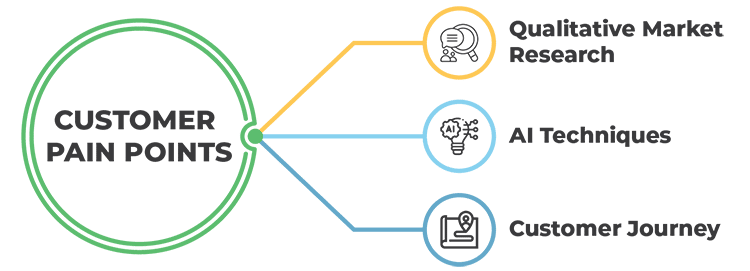Understanding and Addressing Customer’s Pain Points
Understanding the customer journey is one of the best methods to generate brand credibility. Knowing how customers view your brand and how to alleviate customer pain points will help you adopt the best customer experience initiatives. A positive brand experience is critical in retaining customers.
To keep customers satisfied, you must first identify their concerns. Companies of all sizes must work hard to identify customers’ pain points to attract and retain customers through a consistent experience.
Let’s first define customer pain points before diving into how to identify and resolve them.
Customer Pain Points: What Are They?
Customer pain points are the issues that every current or prospective customer is facing in the market today. They are essentially the issues that customer faces when they interact with your product or brand.
Since there are so many distinct challenges that may be included, it can be difficult to mention every one of them. Finding your customers’ pain points entails a variety of steps, such as thinking creatively and placing yourself in their position.
Even though a pain point may represent a particular issue, no matter how big or small, it is usual practice to classify pain points to understand better how to address them. Let’s look at some typical pain point classifications.
Classifying the Most Common Customer Pain Points
When trying to comprehend customer pain points, there are four main areas to consider. Pain points typically fall into one of these important categories for nearly every customer who has a problem or concern.

Financial
The financial pain points symbolize the difficulty of overspending on the existing business, resulting in financial stress. The firm’s goal should be to convey to potential customers the value they will receive in acquiring its products.
Customers like variety. They are always on the hunt for cost-effective solutions that provide them with more services for their money. Businesses must prepare for budget-friendly solutions and customer-friendly subscription programs that meet customer expectations while aligning with corporate objectives.
Customer care and sales teams must grasp the customer’s expectations, competition standards, and budget to provide an optimum-priced solution that meets the customer’s demands.

Productivity
- Has your support agent had trouble rerouting inquiries to the relevant team?
- Have they ever had difficulties resolving consumer issues?
- Did your team fail to meet the Service Level Agreement (SLA) for offering a solution?
If you answered yes, you are experiencing productivity issues.
Customers want a response as quickly as possible when they contact your customer service department. They demand flawless services from the businesses they pay to. On the other side, productivity issues might impact the effort you add to customer care and agent productivity. These internal inefficiencies may cause customers to either discontinue their association with your brand or make them more likely to choose a rival.

Processes
Customers typically complain about process pain points because they seem avoidable – yet the consumer is compelled to suffer them. Customers usually prefer more accessible products or services over less-priced ones that are more challenging to use.
If you do a customer needs analysis to view your company from the customer’s point of view, you will feel assisted in finding these pain areas and connecting all of your actions.
Furthermore, make the information on your website or app simple to find, with viable business hours and easy access to tutorials and FAQs for common issues.

Support
You must create your company with a customer-centric perspective to eliminate client pain points. It involves offering your customers omnichannel support and more convenient customer service.
Customers may waste time finding out how to contact you or waiting for staff members who are overworked with assistance requests. This makes customer service issues among the most time-consuming.
How to Identify Customer Pain Points?
Regardless of the company size, delivering a positive customer experience aids in achieving commercial success. Organizations must be able to effectively handle any complaint, including those regarding pricey services, poor products, faulty connections, and poor customer service.

Here are three methods to pinpoint those pain points before it’s too late if you want your product or service to become the next big thing and boost customer loyalty.
Conduct Qualitative Market Research
Understanding your customer’s needs is essential to figuring out their pain points. You must carry out qualitative market research, which entails charting customer journeys and examining data about prospects’ pain points.
Through qualitative market research, customers may elaborate on the issues they are experiencing. Giving customers the option to explain their problems would make it simpler for you to pinpoint their pain areas.
With qualitative research, you may provide open-ended questions to potential clients and force them to provide in-depth responses.
Identify Customer Pain Areas Using AI Techniques
Voice of customer analysis helps you to track customers’ thoughts about your products and services, as well as their reactions to pricing, processes, and so on, throughout the customer journey. Undoubtedly, you’re already gathering meaningful consumer feedback through emails, live chats, and customer support issues.
Most support requests are made on social media sites. You can learn about the interests of the customers and what irritates them the most if you spend more time there. You may continue to monitor social media to identify customers’ problems and potentially attract them to your offering.
Understanding Customer Journey
Customer journey analysis enables your business to make greater use of in-depth data to support current customers and provide them with products and services tailored to their preferences and buying habits. Additionally, it attracts new customers and prevents you from losing prospective customers in the middle of the client journey.
Client journey analytics is essential in completely understanding your customer base, delivering a seamless experience, and giving the best possible customer service for your company. Customer journey analytics is the cornerstone of developing customer-resonant experiences.
It helps leverage customer data to uncover helpful information about them and enhance their shopping experience. Analyzing these pain points will enable you to make an informed choice when it comes time to review and modify your customer experience plan.
How to Address Customer Pain Points and Improve their Experience?
Once you have identified and classified your customers’ pain areas, you must fix them to continue providing an exceptional customer experience.
Establish a Feedback Management System
Customer feedback is essential to your customer experience analytics and business success. Create a feedback management system to assist you in tracking and analyzing customer complaints. It makes it possible to maintain contact with your current clients while continually improving your products and services to satisfy the demands of new customers.
Optimize Customer Journey
Once you’ve determined if the existing solutions solve the challenges highlighted by your consumers, you can begin the process of overcoming roadblocks and personalizing customer experiences.
Another method to see if the journey map works for your consumers is to go through it yourself, experiencing every unexpected halt. You could even want to bring in experts from other teams to handle problems from all sides.
Internal Operations Automation
You must optimize internal operations to streamline processes, reduce costs and boost output. Reduce customer wait times by using your help desk software to ensure that specific issues are getting escalated to the right teams. You may also utilize the built-in automation tools to automatically launch time-based escalation procedures to meet your Service Level Agreement (SLA).
Identify Frequent and Simple Ways to Resolve Customer Pain Areas
Use live chat and chatbots to automatically react to frequent inquiries and resolve issues that do not necessitate the use of customer support agents. You might need to re-evaluate employee training to ensure that customers are getting onboarded successfully to reduce future problems.
Understanding Customer Pain Points and Drive Satisfaction: A Course5 Case Study
One of the leading global vendors of IT services wanted to assess the satisfaction levels of customers with their brand vis-à-vis their competition. The client wanted to analyze the key drivers of both the customer’s pain points as well satisfaction, examine loyalty, and the willingness of customers in promoting the client’s brand. These inputs would feed into the client’s marketing campaigns, as well as product planning teams.
The research program was based on the “Net Promoter” approach. The study was conducted twice a year with over 6,000 data points under each wave. The study covered around 78,000 respondents across 20 countries.
Analytics/Reporting covered tracking of NP scores, Key driver analysis, frequency tabs, regression analysis, max-diff analysis and conjoint analysis.
Key performance metrics like Net Promoter Score, NP Drivers, Net Delight Score, etc., delivered consistently and were being used to monitor and improve service levels. Findings from the study were used by the client product teams to carry out improvements to the products and address any pain points being faced by customers. The study helped the client with better product development, and the designing of specific campaign strategies to trump key competitors.
Identifying customer pain points has never been easy. While making assumptions is simple, you must have enough information to know what your clients want before they realize it. With the massive volumes of customer data being created, and with access to AI-powered solutions for analyzing the data, deeper and more accurate now available through automation.
Course5’s analytics solutions can help you understand your customers, improve your operations, and deliver true value to customers at an optimal ROI.
Don’t miss our next article!
Sign up to get the latest perspectives on analytics, insights, and AI.




